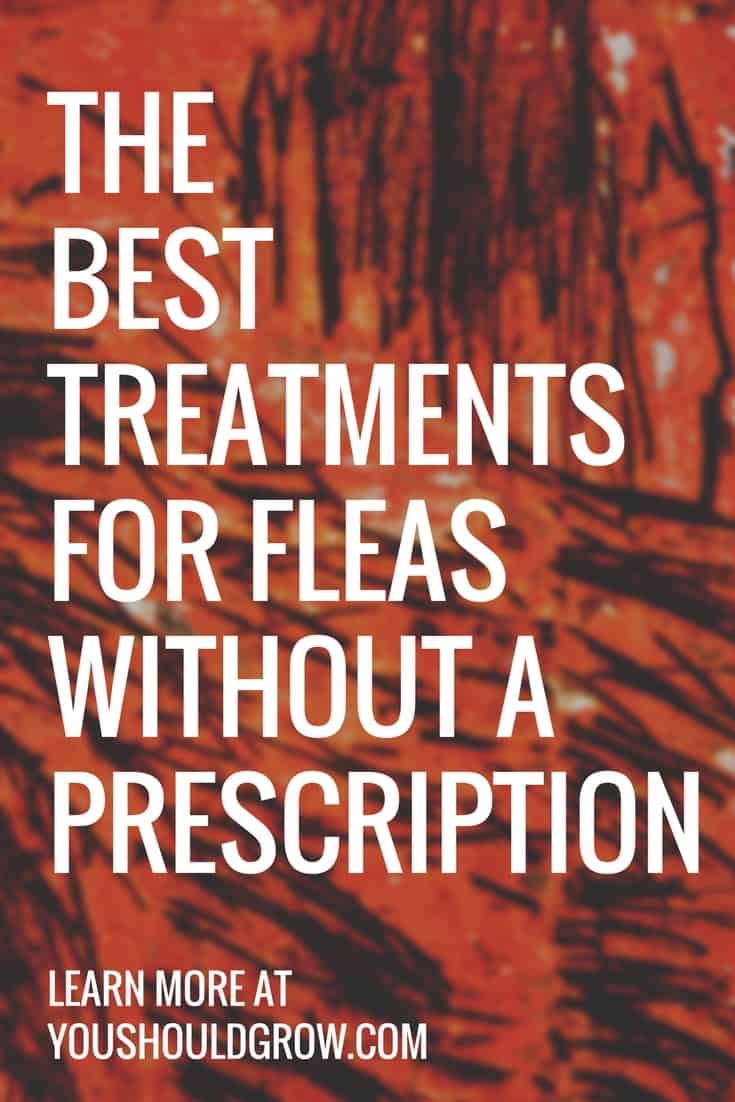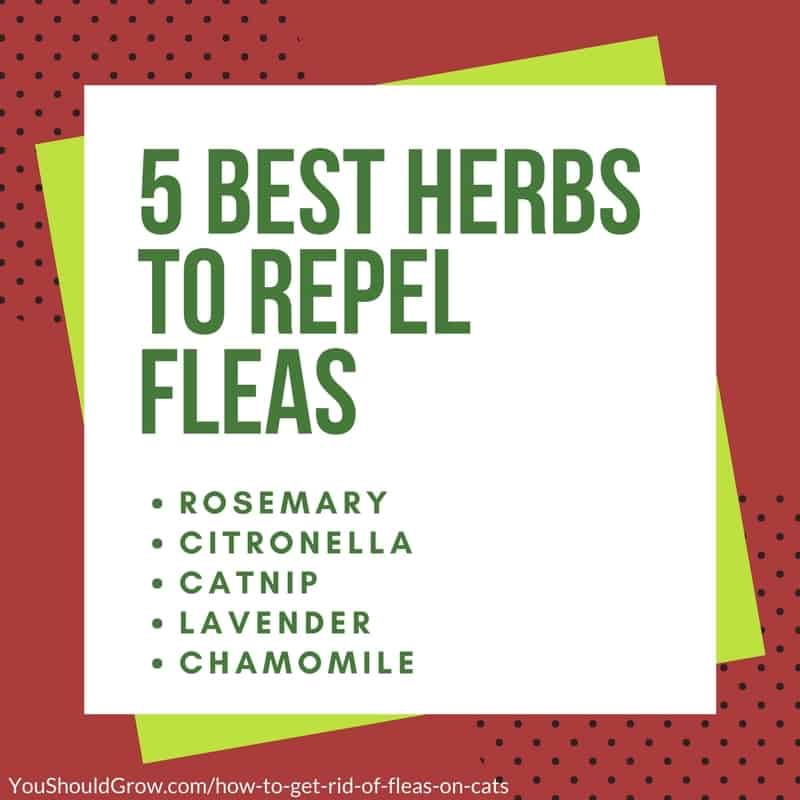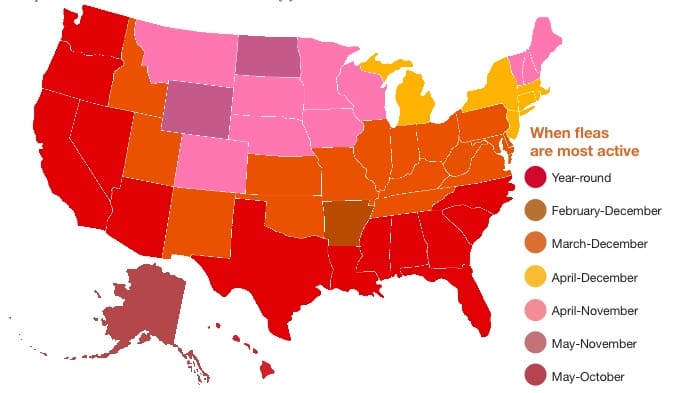Get Rid Of Fleas On Cats And Dogs (A Vet’s Top Choices)
As an Amazon Associate and member of other affiliate programs, I earn from qualifying purchases.
When I worked as a small animal veterinarian, getting rid of fleas on cats and dogs was a very common concern for pet owners.
Pets are exposed to fleas in their home environment both indoors and outdoors. Since they prefer cats and dogs to other hosts, an infestation of your pet, their pen, and your home can occur very quickly – sometimes even before you realize your cat has fleas.
So the first thing you want to do if you find fleas on Fifi is kill them.
Get rid of fleas on cats FAST
The fastest product to kill fleas on cats is Capstar. Capstar is available without a prescription, is inexpensive, and begins to kill fleas within 30 minutes. Sounds wonderful, but it only works for one day.
Capstar is extremely affordable at just a few dollars a pill, and it can be bought at your veterinarian’s office or local pet store.
Flea bites are very irritating and can make your kitty or puppy act crazy. Capstar is the easiest way to get rid of fleas on your cat (or dog) fast.
You should also bathe your dog in a gentle shampoo that is safe for its eyes. Your pet has not only live fleas but flea eggs and flea dirt (a term used for flea feces) as well.
A bath will wash all that away as well as relieve some itching and soothe irritated skin.
5 steps to get rid of fleas in your house
If you follow these steps, you’ll find it’s not very difficult to get rid of cat fleas fast, and you won’t need to resort to using chemical bombs or expensive pest control companies.
Basically, you need to clean your house very well making sure to do these things:
- Wash your cat or dog. Any shampoo will do as fleas will drown and die in the water. If your pet is very irritated from flea bites, try a soothing oatmeal formula.
- Wash all bedding where your pet sleeps or fleas have been seen. You don’t need any special soap here either, just wash the bedding in your washing machine as usual.
- Replace any filling in dog or cat beds. If you can’t remove and replace the bedding, you’re better off buying a new bed for your pet. Flea eggs, larvae, and pupae are already hiding inside of the filling so you need to get rid of them.
- Vacuum. Every. Day. You can kill fleas in carpet simply by vacuuming. Flea eggs are not sticky and they’re easily sucked up by your vacuum. Sprinkle DE + Borax (in desperation, use Sevin Dust) into your vacuum bag or container to kill live fleas that get sucked in.
- Use a flea preventative on your pet. Combining these steps with one of the recommended flea pills or collars listed below for at least 3 months will get rid of your flea problem.

Treating flea bites on cats and dogs
Usually getting rid of the fleas will take care of the problem, however, the reaction to the bites can be very irritating for some pets.
- A bath is the very first step for soothing flea bites on your cat or dog. Try a soothing oatmeal shampoo or even dish soap to provide relief for your pet. I’m not a fan of flea shampoos that contain pesticides. I can’t tell you how many times I’ve seen a pet with live fleas and the owner said they just washed them in flea shampoo.
- Benadryl can be effective at calming the itchy feeling, but it’s not the best. If you want to try it, Benadryl dosing for pets is 1/2 to 1 mg per pound twice daily.
- Topical ointments and sprays that contain cortisone can be helpful as well. Be careful not to apply to the face or on a pet that is likely to lick the solution off.
Preventing fleas on your cat or dog
Prevention is really the best option if you live in an area that is prone to fleas. Fleas are most active during the warmest times of the year, but in some areas of the US, we can see flea problems year round.
It’s a common thought that you can discontinue flea prevention in the winter months, but as you can tell by the map below, a majority of our country will experience trouble with fleas for 10-12 months of the year.
There are many natural options for preventing fleas on your cat or dog, but if you’re in one of the hot zones for fleas, you may find that natural methods are just not enough to truly take care of the problem.
And if you or your pet are allergic to flea bites, there’s no reason to torture yourselves by trying to avoid using pesticides for flea treatment. Judicious use of pesticides is nothing to be ashamed of if it improves your health and quality of life.
Fortunately, there are a lot of flea prevention options for your pet.
The best flea collar
One of my favorite products for pets with flea problems/allergies is the Seresto Collar. Unlike cheap flea collars which only work within a few centimeters of the collar, the Seresto collar will actually kill fleas over your pets entire body.
You can leave this collar on for flea control up to 8 months. Seresto collars do not require a prescription and can vary in price from $30 to $80. The cost tends to be higher at your veterinarian’s office because veterinarians do not have the buying power that stores like Wal-Mart and Target do.
So while you can get a better price by purchasing from your big box stores, you’ll be supporting a local business by purchasing from your vet. Be sure to ask about any coupons or rebates from the manufacturer as you can sometimes get a rebate coupon when you purchase from your veterinarian.
In my experience, Seresto has been very effective for most pet families. Occasionally, a pet will be allergic to the collar itself. If that happens to you, the manufacturer may refund your purchase price and pay for some or all of the treatment.
I haven’t been convinced that there’s been any flea resistance to Seresto. All flea preventatives take some time to kill the fleas, so pets living in an area where there are lots of fleas may still have live fleas seen on them from time to time.
Pros of the Seresto collar:
- Works continuously for 8 months with no monthly pill to administer
- Safe for pregnant and nursing dogs
- Also kills ticks
Cons of the Seresto collar:
- Can be expensive
- Does not contain heartworm or intestinal parasite treatment
- Occasionally allergic reactions will occur
The best flea pill for cats and dogs
Honestly, there are lots of really good options for flea control in pill form. I like Comfortis because the active component, spinosad, is organically derived from bacteria that live in the soil.
We use spinosad sprays for caterpillars in the garden, and I’ve even seen homesteaders use it to treat their chickens for lice. Unfortunately, although it’s available in the garden department as a spray, this flea pill for cats and dogs is available by prescription only.
Pros of Comfortis:
- Naturally derived compound that is fast and effective against fleas
- Convenient once-monthly pilling
- Is combined with milbemycin in Trifexis to treat heartworms, fleas, and intestinal parasites in dogs
Cons of Comfortis:
- May cause vomiting
- May lower seizure threshold in epileptic pets
- Not safe in pregnant or lactating pets
The longest-lasting flea pill
Bravecto is a great product for those who live in areas with a heavy flea burden. Bravecto is a flavored chewable pill or topical solution that kills fleas and ticks on dogs and cats for up to 12 weeks.
Bravecto is available from your veterinarian by prescription only and costs about $70 per treatment.
Pros of Bravecto:
- One treatment kills fleas and ticks for 12 weeks
- Safe for pregnant and lactating dogs
- Also treats some types of mange
Cons of Bravecto:
- May be expensive
- Pets must be over 6 months old
- Use with caution in pets with a history of seizures
What about Frontline?
Frontline has become much more affordable since the active ingredient, fipronil, came off patent a few years ago. However, even before the decline in cost, we were seeing a decline in efficacy which may indicate that certain populations of fleas were developing resistance to the treatment.
That said, I know some pet owners who find that Frontline is still very effective, so it might be worth a try for your family. It’s also an inexpensive and safe choice for pregnant and lactating dogs and cats.

Home remedies for fleas on cats and dogs
If you don’t have a heavy flea burden and you want to try natural methods for controlling fleas, then I have some good news. There are some natural methods for controlling fleas that work great.
But you need to have realistic expectations.
If your pet already has a lot of fleas, scabs on their skin, or a skin infection, then you should see your veterinarian for medical treatment. You’ll end up spending more time and money on treatments that don’t work and medical complications for your pet if you avoid going to the vet.
Let your pet’s doctor do his or her job, follow their recommendations, and then use these natural methods as adjunct approaches for controlling further flea problems.
Food-grade diatomaceous earth (DE) + Borax will kill fleas
A 50:50 mixture of DE and Borax will help control your flea problem. It works by scraping through their soft skin as they crawl through it causing them to dry out and die.
Be cautious spreading DE in confined areas as the aerosolized powder when inhaled in large amounts can cause lung damage to people, children, and pets. DE is, however, safe when applied directly to your pets and is not harmful if ingested orally (in small amounts).
Sprinkle the Borax + DE mixture in your pet’s bedding, around the edges of their housing, and under furniture, furniture cushions, and along baseboards in your home. (This is the same method I use for cleaning my chicken coop.)
While DE + Borax can help minimize a flea infestation, it’s not a great option for treatment in severe cases. I recommend using this method in addition to other flea control methods mentioned in this article.
Use flea-repellent bedding
Some great options for flea-repellent bedding include cedar and hemp. Both of these materials are repellent to fleas and may help reduce flea infestations.
Many pests find the scent of cedar and hemp unpleasant, so using either of these materials as bedding for your pets can decrease your problem with fleas.
Both will decrease in efficacy over time, so you’ll have to replace the bedding periodically. For pets that sleep indoors, use a bed with a removable & washable cover so you can refresh the bedding as needed.
I use hemp bedding in my chicken coops, and I found the best price including shipping for a 33# bag on Amazon. Cedar flakes are easy to find in pet stores and online.

Use dried herbs to repel fleas on cats and dogs
You can also sprinkle dried and ground herbs to help repel fleas on your cat or dog. Some good herbal options for repelling fleas include:
- Rosemary
- Lavender
- Chamomile
- Catnip
- Citronella
Using essential oils for fleas on cats and dogs
Essential oils can act as repellents for fleas, but you must be very cautious when using EOs with pets. If you overdo it, you can cause illness or even death.
I do not recommend applying essential oils directly to your pets without direct veterinary supervision. It’s very easy to apply too much oil to your pet and cause them harm. Plus, cats and dogs are very likely to lick any areas where you apply oils and, when ingested in excess, essential oils can be extremely toxic.
Instead, try adding a couple of drops to your diffuser or sprinkling a couple of drops around their favorite lounging locations.
Some essential oils that can repel fleas include:
- Lemon
- Lemongrass
- Cedar
- Pennyroyal
- Rosemary
- Lavender
- Eucalyptus
- Basil
- Thyme
- Clove
- Peppermint
In her book for using essential oils in veterinary medicine, Dr. Shelton recommends using Longevity essential oil blend by Young Living for keeping fleas off of dogs. It is not generally used for cats.
Her recommended oral dosing for dogs is
- 2-3 drops per day for small dogs
- 3-5 drops every day for medium-sized dogs
- 6-7 drops maximum per day for large dogs
When to see a vet about fleas
When a flea bites the skin, it injects a small amount of its saliva to prevent the blood from clotting at the site so the bug can feed. The saliva injected may contain parasites and causes an intensely itchy local reaction.
What’s worse, is that some pets and people are allergic to flea saliva causing an even more intense reaction.
Your cat has fleas plus bald spots, open sores, or stinks
A pet with a severe flea allergy will lose hair exposing red, raw skin and scabs. Often they get a skin infection as well which causes more itching, scabs, and a bad odor.
Sometimes, pets are so allergic to fleas that even one flea bite can cause obsessive itching and open sores. Left untreated, flea allergies and infestations can lead to serious skin infections that are uncomfortable for your pet and expensive to treat.
Your cat has fleas and is lethargic or won’t eat
Not only are fleas a carrier of certain blood infections, but because fleas feed exclusively on blood, small cats and dogs can become anemic (having low red blood cell counts) with a heavy infestation of fleas.
In addition to being extremely uncomfortable, flea bites can lead to secondary skin infections and if the flea is ingested it can give your pet tapeworms.
So you can see that it’s important to make sure you’re treating and preventing fleas before they become a major issue. And hopefully, this article has given you plenty of ideas to get your pet and home comfortable again.
Have you struggled to get rid of fleas on cats or dogs?
Share your experience in the comments below.
Disclaimer: Although I am a veterinarian, I am not YOUR veterinarian. The information in this blog post is not intended to diagnose, prescribe, or treat medical illnesses. If you are concerned that you or your pet are ill, you should visit a qualified healthcare professional for treatment right away.




I am helping out a neighbor with his feral cats that are all covered with fleas and the younger ones have uri’s. For the fleas I’ve started putting DE on the ones I can catch. Not sure how else I can help the flea issue. I can’t save them all:(
Hi, Mary. It’s true you can’t save them all – especially when they’re feral. The DE should help a little, but it sounds like they need to be caught and taken to a vet to be treated and neutered. Have you talked to a local rescue group to see if they can help with that?
My cat got outside came home w fleas I used coconut oil for the fleas and it worked. No itching and his coat is shiney. Best of all it’s non toxic
what did you do with coconut oil ? rubbed on cat’s coat – what did you do?
What is DE ? My cats have fleas and I wS going to use peppermint extract on them because all the “all natural” products in the store use it Your site says I can DE and Borax directly on my cats????
I have no idea what DE is…please advise.
I have 6 cats and two of them are nursing we recently moved to Oklahoma I’ve never had a flea problem before but once I moved here I have an infestation with my cats and I try and try and nothing seems to get rid of them I don’t know what to do now the little babies I’ve seen movies on I give them baths to ease the pain but I want to get rid of the fleas completely inside and out at my house do you have any suggestions